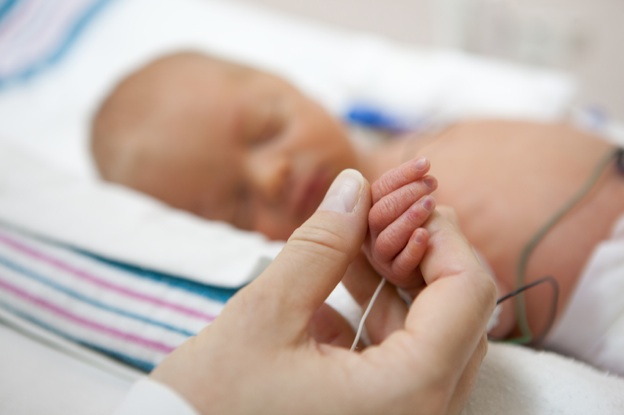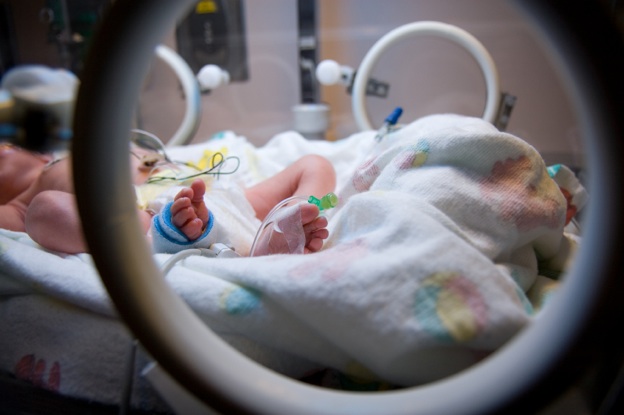SingaporeMotherhood | Baby & Toddler
April 2012
True Story: Baby Premature, Mum In A Coma

For two days after she had delivered her baby prematurely, Joycelyn lay in a coma. Her husband shuttled between the Intensive Care Unit and the neonatal ICU, burdened with the possibility of losing both his wife and son. Though mother and child have since pulled through, their journey has not been easy. Joycelyn, a 30-year-old executive, shares her story of courage and determination, and how she helped her son overcome the odds.
Code Red Emergency
Joycelyn was in her 24th week of pregnancy when she developed a minor vaginal bacterial infection. She inserted a pill to treat it in the morning and went to work as usual. She felt a small gush of water, but simply used two sanitary napkins and carried on with her day.
[banner][/banner]
Recounting the events leading up to the delivery, Joycelyn said, “Around 2 am the next morning, I felt an intense pain in my lower abdomen. There was bloody discharge as well. It was very painful by the time I reached the Accident and Emergency department of KK Women’s and Children’s Hospital (KKH). Being a first-time mother, I had no idea that I was going into labour. I was wheeled into the delivery suite and told that my water bag had burst. The doctors told me to try to keep the baby inside for as long as I could because he was too premature. That night, I was given a steroid injection so that my baby’s lungs would mature faster. However, labour pains started the next evening.”
Joycelyn’s labour was classified as a “code red emergency” because at 24 weeks of gestation, baby Kayden was too small to be born. His lungs were not fully mature, and it was too dangerous for a Caesarean section. Yet, he might not survive a natural delivery as he was in a breech position and could possibly get stuck in the birth canal.
The head gynaecologist explained that Kayden could either not live, or survive with many medical complications and perhaps die young. Recalling her pain, Joycelyn said, “It was tough when we were asked to consider the possibility of giving birth to him and just letting him die, should he require resuscitation. My husband and I were crying like mad.”
Two lives Hanging By A Thread
During the delivery, Joycelyn was surrounded by a team of doctors and midwives, while a neonatologist and nurses waited on the side with equipment to resuscitate the baby. Recalled Joycelyn, “It only took 45 minutes to push Kayden out as he was so small. He came out butt first, not breathing. In that split moment, my husband had to decide whether to resuscitate or not. I was too dazed from the delivery to even talk. He looked at our son and told them to resuscitate him. It took them two tries before Kayden took his first breath. They immediately wheeled him to the NICU.”
However, the worst was not over yet, as Joycelyn could not breathe after delivering: “My vital signs went down, and I slipped into a coma for two days. I was admitted to the ICU with a lung infection and placed on a ventilator. The doctors told my family that I may or may not wake up.”
Fortunately, Joycelyn pulled through after a specialist from another hospital was brought in, and her medication changed. A subsequent medical report showed that she had most probably suffered an adverse reaction to the steroid injected the day before.
Against All Odds
A week after waking from her coma, Joycelyn was finally able to visit Kayden. Recalling her first glimpse of him, she described, “He had around ten wires all over him. It was really tough but the nurses said that he was a fighter. He survived because he had a good weight of 800 grams.”
Because he was extremely premature, Kayden required medication to close a hole in his heart and to dissolve the calcium in his kidneys. In addition, he needed surgery for his hernia. Unlike some other premature babies though, Kayden was not affect by Retinopathy of Prematurity (ROP), which could result in a loss of vision.
However, Kayden suffered from apnea and could not always breathe on his own. Joycelyn recalled the three-and-a-half month emotional roller-coaster ride as her son fought for his life: “Many times, he would stop breathing and turn blue. We all thought that he was not going to make it each time. It occurred four to five times, when he would be cleared to go to a step-down unit and then be wheeled back into NICU again.”
A Mother’s Love And Support
Throughout Kayden’s hospitalisation, Joycelyn faithfully visited him daily, often staying on long after visitation hours just to express breast milk for him, and spending up to eight hours at the hospital on weekends. To facilitate mother-and-child bonding, Joycelyn was taught to carry Kayden using the Kangaroo Care method.
After four-and-a-half months, Kayden’s weight reached 2.7 kg, and he was finally discharged, together with a stack of medication.
Because Kayden’s lungs were weak from birth, Joycelyn recalls him “crying softly and coughing all the time.” As a precaution, she bought an air filter and kept her dog away to reduce the amount of irritants entering his lungs. However, he would still get cough, flu and fever on an average of once a month, and take a longer time to recover than his peers.
Kayden also required regular therapy to aid his development. Joycelyn recalled, “Every month during the first three years, he had at least three appointments with the neonatologist, speech therapist and occupational therapist.”
Now that Kayden is four, he does not need to go for therapy as frequently and Joycelyn coaches him at home to help him along. She still takes precautions to keep him in good health, putting him on a strict diet, avoiding smoky places and choosing a pre-school with non-airconditioned classrooms. Her efforts have paid off, as Kayden only falls sick once every few months now.
Though his development of speech and fine motor skills may be slower, and he could possibly be more prone to hyperactivity or autism, Joycelyn is still thankful for her son. “Not all mothers with such extremely premature kids are as lucky as me. Kayden belongs to one of the few who managed to survive with no serious complications,” she reflects.
Asked how she would advise other mothers who are struggling through similar situations, Joycelyn offers, “For mothers like me, I suggest that other than counting your blessings, keep your child as healthy as possible. I do not take for granted that every time Kayden gets sick, it is just the same cough, flu or fever. I continue to take it seriously so that it will not have serious consequences.”
When the baby grows older and has difficulty forming words, expressing himself or feels frustrated when he cannot do what his peers are doing, Joycelyn adds encouragingly, “Even if it means more teaching and therapy, slow development can be reduced. Have faith, patience and love when it comes to premature kids. It helps them a lot in their development.”
All content from this article, including images, cannot be reproduced without credits or written permission from SingaporeMotherhood.
Follow us on Facebook, Instagram, and Telegram for the latest article and promotion updates.






